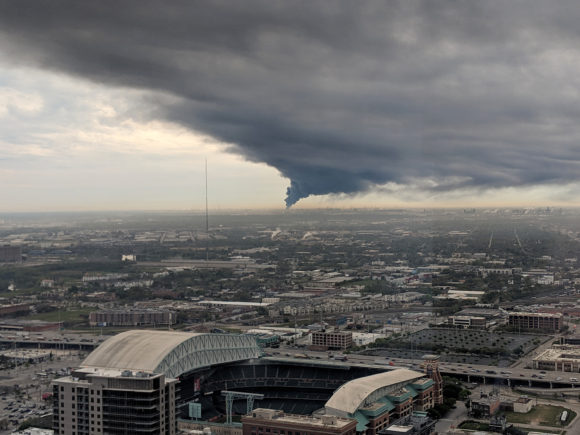Federal and local investigators are weighing a probe of the Houston chemical blaze as hazardous compounds waft near the burned-out site.
The U.S. Chemical Safety Board “is following up on the incident and should be making a decision to send an investigator shortly,” spokeswoman Hillary Cohen said in an emailed statement on Wednesday. Hours earlier, firefighters extinguished the last of the fires at Intercontinental Terminals Co.’s petrochemical complex that menaced the fourth-largest U.S. city for almost four days.
Prosecutors in Harris County, which encompasses Houston, also said they were mulling an investigation and would decide once environmental agencies have made their assessments.
At a nearby facility in the refining and chemical row east of downtown Houston, Royal Dutch Shell Plc alerted workers that it detected benzene — a cancer-causing oil byproduct. The company issued a so-called shelter-in-place order out of an “abundance of caution” and operations continued uninterrupted. The notice was later lifted. Shell noted the benzene emerged from sources outside the plant, which is less than 5 miles (8 kilometers) from the ITC property.
Root-Cause Analysis
The CSB, a Washington-based panel formally known as the Chemical Safety and Hazard Investigation Board, launched extensive probes into the BP Plc refinery disaster in nearby Texas City that killed 15 people in 2005, as well as the Deepwater Horizon catastrophe that killed 11 in 2010. No one died or was injured in ITC’s incident.
A federal investigation “will be akin to what FAA does when a plane crashes,” said Jonathan Baughman, a partner who chairs the oil and gas practice at McGinnis Lochridge in Houston. “They’ll be doing root-cause analysis as well as looking to see if there were any deficiencies with the procedures in place.”
Reuters reported earlier Wednesday that both the Texas Commission on Environmental Quality and Harris County district attorney’s office were looking into the fire.
ITC officials warned that smoke and steam may still be visible from the area, and firefighting crews will continue to spray foam and water on the tanks to prevent re-ignition.
Schools had already been ordered closed before the fire was extinguished, after shifting weather patterns sparked concern that the plume of smoke might sink to ground level, making breathing hazardous.
Current readings show no hazardous concentrations of particulates or volatile organic compounds, known as VOCs, according to Adam Adams, an official with the U.S. Environmental Protection Agency. The agency is in the process of taking water samples, with results expected Friday, he said.
Weather Protecting Houston
Houston has been lucky so far.
Every night since a petrochemical storage site erupted in flames on Sunday, a lid of warm air 400 feet to 600 feet (120-180 meters) over the city hasn’t been stout enough to halt the ascent of a super-heated torrent of inky smoke rumbling out of the destroyed tanks. That means residents and wildlife at ground level have been spared the worst of the choking, toxic cloud.
“The heat is creating enough warmth to rise rather vigorously to push through” the warm layer, said Charles Roeseler, a meteorologist with the National Weather Service in Houston. “All things considered, we have been lucky.”
Normally temperatures get cooler the higher into the sky you go. With nightly inversions such as those in place since the weekend, though, there is a layer of warmer air that “creates a lid,” Roeseler said. He likened it to a covered pot of boiling water: The steam stays trapped under the lid. If Houston were the pot, its lid is too flimsy to hold back the steam.
Houston is also catching a break because the inversion has been between 400 to 600 feet, which means even if the smoke did get trapped it would still be off the sidewalks. If the nights had been foggy, typical of this time of year, the inversion would have been closer to the ground.
“In spring, in southeast Texas and in the Houston area that hasn’t happened,” Roeseler said. “We have been fairly fortunate.”
Was this article valuable?
Here are more articles you may enjoy.


 Auto Insurer Fined for Data Breach That Impacted 45K New Yorkers
Auto Insurer Fined for Data Breach That Impacted 45K New Yorkers  An Unusually Active Hurricane Season Is in Store for the Atlantic
An Unusually Active Hurricane Season Is in Store for the Atlantic  FAA Must Do Better After Midair Collision, Acting Chief Says
FAA Must Do Better After Midair Collision, Acting Chief Says  Alibaba Teams up With BMW to Develop AI for Cars in China
Alibaba Teams up With BMW to Develop AI for Cars in China 